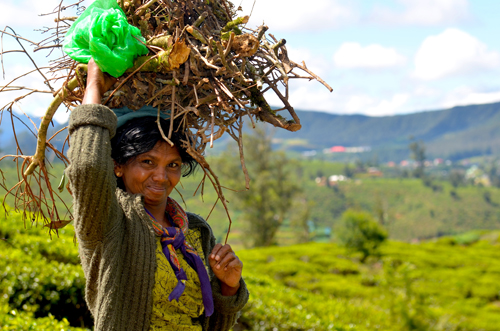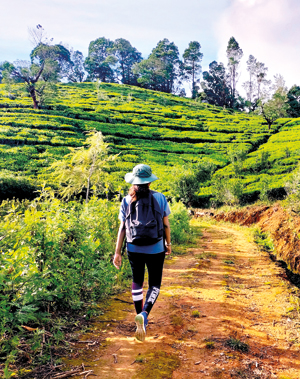Climb every mountain, seek different stories

Pekoe Trail: Connecting hundreds of hill country trails together. Pix by Juliet Coombe
The Pekoe Trail is an exciting new 20 to 25-day, 300 km network of trails starting in Kandy, that has already been credited as one of the five most incredible walks in the world by the Financial Times in London. Funded by the European Union and USAID, this epic socially sustainable hike has been designed for responsible travellers with a love of meeting people and respect for their culturally rich traditions.
The interconnecting paths cross over seven valleys, many tea plantations, and over some of Sri Lanka’s most stunning mountain terrain, including spectacular waterfalls where lovers leapt to their deaths and gold was hidden under giant boulders in ancient times. Every day is inspiring as you discover awesome pilgrimage sites, great lakes, meandering scenic peaks, unique architecture and deep valleys full of birds, wildlife and occasional forests.
The extraordinarily diverse Pekoe Trail has been purposefully developed to connect many culturally interesting spots together from important hill station towns, through time-locked villages with ancient festive traditions, old colonial train stations, and tea museums telling the human story.

The Pekoe Trail is full of spiritual symbols like the sacred trident
“The Pekoe Trail is unique, as it’s an all-year-round heritage tea trail that does not suffer from extreme weather like other countries and has been designed so each section can be walked between 8 and 16 km a day, any time of the year,” explains Miguel Cunat, Heritage Trail Advisor to the project. The Pekoe Trail is scheduled to fully open with all signage and infrastructure in place from June 2023. In the meantime, people can walk on many stages of the trail already using their maps and they want the experience to be fully immersive – not how fast a person can walk 300 kilometres – but how insightful and most importantly, inclusive, the experience has been for all.
One of the key goals of the project is to protect and preserve both the physical and cultural heritage of the Sri Lankan tea country. I love that the Pekoe Trail has been designed as a thread that connects important landmarks, from Adam’s Peak to the Adisham Bungalow, and from Lipton’s Seat to the Nine Arch Bridge. The concept, you will discover as you walk, is to fill the Pekoe Trail with variety, promote the best of the region, create interesting milestones and make each day as different and fun as possible.
People have been walking these hills for millennia. One of the earliest mentions of a significant trail in the hills of Sri Lanka relates to the Sri Pada pilgrimage. The 5th century chronicle, the Mahavamsa details Buddha’s visit to the island and to its highest mountain point, Sri Pada or Adam’s Peak. Marco Polo, while travelling the world in 1298, also mentions the Peak in his journals, and the enigmatic Arab traveller, Ibn Battuta, climbed it in 1344.

Miguel Cunat
The story of these tea trails begins nearly 200 years ago, when the country was still a British colony. The interlinking mountain paths started expanding from1824. Later tea was brought to Ceylon by the British and the British planters developed and expanded these pathways for their workers within their own estates and between the various settlements across the mountain ranges so they could take their tea to market, creating this vast network of walking areas that tea-pickers ascend daily, along with the cheeky hill country goats that love nibbling on tea plants, chickens and even the occasional elephants who can reach heady heights moving almost vertically upwards. And, if you are very lucky, a leopard popping out of nowhere at dusk.
The network of trails now known as the Pekoe Trail reflects the woven fabric of many legendary, raw and real stories: those of religious pilgrims, estate workers, plantation owners, photographers, tea artists, travellers, writers, hoteliers and now walkers looking to escape our over busy world.
Whether you travel with knowledgeable local guides who take any walk to a whole new level or use the Pekoe Trail maps, each and every hike is different, as nature is an ever-changing canvas, like the tea industry. One valley may be fully industrialised, selling millions of dollars of mass produced tea daily, while another, will provide a wholly different experience, where they grow organic and artisan tea in small amounts, and make everyone part of their success story.

Along the trail: Meet the women who walk for miles to get firewood for cooking
All along the trails you can stop and try the local tea or learn more on a factory tour. Night owls can step back in time at one of the old planters’ clubs and even enjoy cricket in perfectly manicured grounds or a game of cards in comfy vintage sofas and tables around a fire, like time capsules from a movie set.
Whichever way you trek the Pekoe Trail, you could be walking through paddy fields and then minutes later forbidden forests, only to vanish an hour later through a secret passageway in the rocks, or climbing tea-bush staircase steps for panoramic photos or stopping to enjoy refreshing cups of tea and doing a tour at a tea factory. The trail also includes two national parks, World’s End, ‘Ella, the home of waterfalls’, prehistoric cave paintings, and a mysterious labyrinth of tunnels through mountains that connect with different religious sites, said to have once been escape tunnels which only a chosen few know the way through.
 If you only have limited time, head for one of my favourite hidden gems, Norwood, a small village in the Central Province, known as ‘The Golden Valley of Tea’; a place you can try picking tea, only to realise it takes both talent, experience and dextrous speed, to keep up with the area’s plucking experts. An idyllic spot to disconnect yourself and discover characters both local and foreign; it is here that one of the most significant 19th century female British photographers, Julia Margaret Cameron, who was totally bewitched by Sri Lankan plantation life, spent time documenting people’s lives. She was buried overlooking the mountains she loved so dearly.
If you only have limited time, head for one of my favourite hidden gems, Norwood, a small village in the Central Province, known as ‘The Golden Valley of Tea’; a place you can try picking tea, only to realise it takes both talent, experience and dextrous speed, to keep up with the area’s plucking experts. An idyllic spot to disconnect yourself and discover characters both local and foreign; it is here that one of the most significant 19th century female British photographers, Julia Margaret Cameron, who was totally bewitched by Sri Lankan plantation life, spent time documenting people’s lives. She was buried overlooking the mountains she loved so dearly.
The Long Valley is a serene spot to stop and just enjoy nature, unchanged for centuries, also full of eccentric characters who are considered the pioneering spirits of Ceylon tea and a great place to share ideas over more cups of tea.
Miguel who can often be found on the Pekoe Trail researching says, “We want this walking journey to be a space for a mutual knowledge exchange between people, and a riveting source of storytelling.” He will be sharing some insights at a talk ‘Stories from the Pekoe Trail’ at ‘Wild & the Sage’ – the cafe bookshop in Unawatuna on Sunday, January 29 at 4 p.m.
Searching for an ideal partner? Find your soul mate on Hitad.lk, Sri Lanka's favourite marriage proposals page. With Hitad.lk matrimonial advertisements you have access to thousands of ads from potential suitors who are looking for someone just like you.


